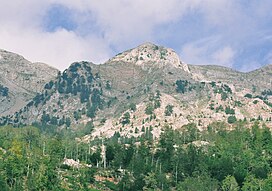

| Munellë | |
|---|---|

View of Munella in Mirditë
| |
| Highest point | |
| Elevation | 1,990 m (6,530 ft) |
| Prominence | 1,028 m (3,373 ft) |
| Isolation | 56 m (184 ft) |
| Coordinates | 41°58′29″N 20°05′54″E / 41.97472°N 20.098454°E / 41.97472; 20.098454 |
| Geography | |
|
| |
| Country | |
| Region | Northern Mountain Region |
| Municipality | Pukë, Mirditë |
| Geology | |
| Age of rock | Cretaceous |
| Mountain type | mountain |
| Type of rock | limestone |
Munellë (def. 'Munella') is a mountain located in northern Albania, stretching along the boundaries of Pukë and Mirditë municipalities. Its highest peak, Maja e Kryqit 1,990 m (6,530 ft), lies between the river valleys of the Great Fan in the northwest and the Little Fan in the southeast.[1]
Composed of effusive rocks at heights of up to 1,400 m (4,600 ft) which are covered by a Cretaceous limestone slab, Munella has an elongated shape, spanning a length of 6 km (3.7 mi) and a width of 3 km (1.9 mi). The top of the mountain has an undulating surface with a slight incline towards the northeast, and is heavily divided into karst pits and funnels. The northwest and southeast slopes create cliffs up to 300 m (980 ft) deep into the limestone layer, whereas the slopes in the effusive rock areas are less steep.
Munella constitutes the watershed between the Great Fan and Little Fan rivers. Oak trees (up to 1100m) and beech trees (up to 1600m) make up most of the vegetation; beyond these heights, the mountain is barren. Its peak is abound with alpine pastures. The region is populated by bears, wild boars, and furry animals like beech marten and the European pine marten, with the wild turkey being a rare sight. Additionally, copper ores are present in the northwest (Tuç) and southeast (Reps).[2]